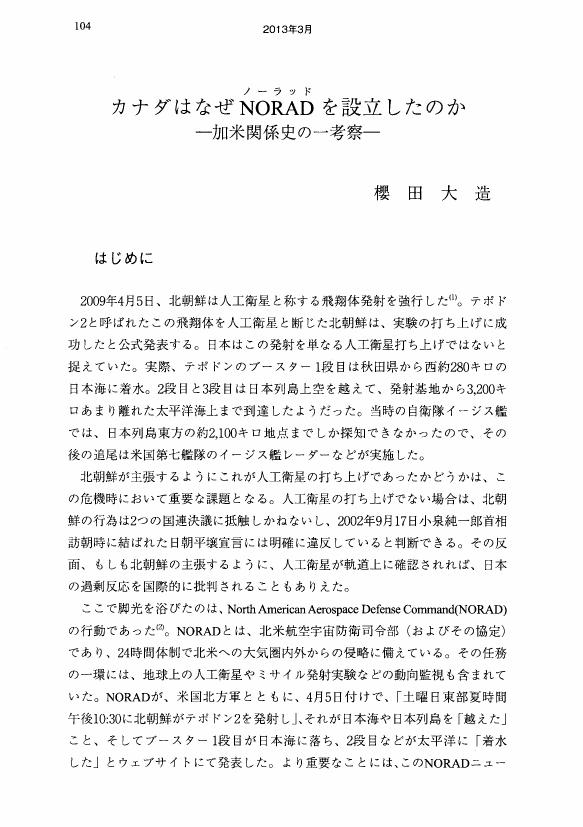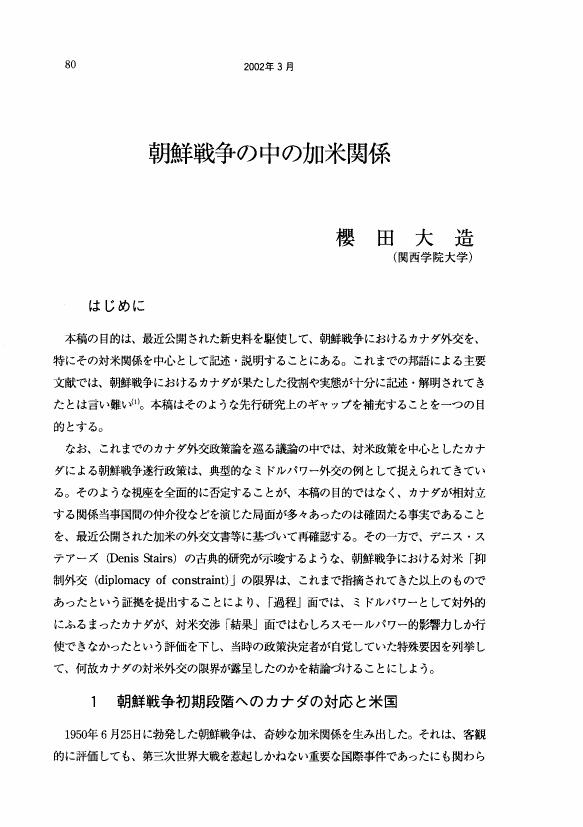1 0 0 0 OA カナダはなぜNORADを設立したのか ―加米関係史の一考察―
- 著者
- 櫻田 大造
- 出版者
- 国際安全保障学会
- 雑誌
- 国際安全保障 (ISSN:13467573)
- 巻号頁・発行日
- vol.40, no.4, pp.104-121, 2013-03-31 (Released:2022-04-07)
1 0 0 0 OA 朝鮮戦争の中の加米関係
- 著者
- 櫻田 大造
- 出版者
- 国際安全保障学会
- 雑誌
- 国際安全保障 (ISSN:13467573)
- 巻号頁・発行日
- vol.29, no.4, pp.80-101, 2002-03-31 (Released:2022-04-28)
- 著者
- 櫻田 大造
- 出版者
- 上智大学
- 雑誌
- アメリカ・カナダ研究 (ISSN:09148035)
- 巻号頁・発行日
- vol.9, pp.87-94, 1992-11-30
1 0 0 0 OA サンローラン=アイゼンハワー時代の加米首脳会談と加米関係、一九五三年
- 著者
- 櫻田 大造
- 出版者
- 関西学院大学
- 雑誌
- 法と政治 (ISSN:02880709)
- 巻号頁・発行日
- vol.54, no.1, pp.31-78, 2003-04
Drawing on the major works of Lawrence Martin's The Presidents and the Prime Ministers and Roger Frank Swanson's Canadian-American Summit Diplomacy, supplement by more recently declassified diplomatic documents found in such series as Documents on Canadian External Relations, Foreign Relations of the United States, and other schloary studies, the paper has as one of its objectives the depiction of the major dyadic and multilateral conflicts in Canada-US relations in 1953. It explores the possible explanations for the actions of leaders in both countries. There are three main reasons for choosing 1953 as the foucs for this study. During the four years and five months of his last term in office, Prime Minister Louis St. Laurent officially met President Dwight D. Eisenhower only four times. However, in 1953 the leaders met twice in reciprocal visits to each other's capital. Scrutinizing the main thrusts of Canada-US relations in that year is, therefore, crucial for an examination of bilateral summitry. Internationally, 1953 is considered to be the beginning of the "thaw" in the Cold War. Joseph Stalin, the Soviet dictator, died in March, and the Korean War officially ended in July. President Eisenhower, whose inauguration took place in January, was in the process of launching his "New Look" policy towards the Eastern bloc. In other words, 1953 was a transition year in the struggle between West and East and is treated as one of those "calm" years in the attitudes of both Washington and Ottawa to communism and Soviet expansionism. The paper is significant precisely because it analyzes Canada-US diplomatic interactions in a normal year. Also, the St Laurent government was somewhat skeptical of a Republican administration after a twenty-year absence from power. The US had not had a Republican president since the 1920s, and memories of "high tariff" Republicans were still vivid among some policy-makers in Ottawa. The paper attempts to cast some light on the attitudinal changes in Canada to the US administration by concentrating on the beginning year of a fresh regime. The paper also tries to reply to the long-running inquiry about Eisenhower's style of governing: one school argues that the president was basically passive and that he delegated the conduct of foreign policy to John Foster Dulles, his Secretary of State; the other school proclaims that he was an active administrator who provided important leadership in foreign affairs. Canadian-American summit-level interactions and relations during 1953 will clarify which view is more accurate. There was, of course, some continuity of issues on the Canada-US agenda after a Republican took the helm. The St. Lawrence Seaway Project was a vital issue for St. Laurent, and he asked for the full support of the US administration in beginning its construction as soon as possible. Both top-level summits were used along with a number of lower-level negotiations to advance this Canadian interest. The US executive office was very cooperative on this issue, doing its best to comply with Canadian wishes. Trade relations were not as successful. By the end of 1953, a few frictions had emerged because of American domestic pressures from those with vested interests in their dealings with Canada. The US Tariff Commission's decision to impose an import quota on oats was especially difficult for Canada because it would gravely hurt Canadian farmers. St. Laurent raised the issue in his first official meeting with the President in Washington. Because of the overly ceremonial nature of Eisenhower's visit to Ottawa in November, however, the issue was not taken up by Canadians, nor was it specifically mentioned in the Presidential address to the Canadian Parliament. It was left to Lester Pearson, the Canadian Secretary of State for External Affairs, and C. D. Howe, Canada's Trade Minister, to sort the matter out. They met Sherman Adams, Assistant to President Eisenhower, in December and threatened retaliation by imposing a contervailing quota on Canadian fruits imports from the US. The US eventually agreed not to impose a quota on Canadian oats if Canada agreed to limit its oats exports to the US to twenty-three million bushels until the end of September 1954. This outcome was acceptable to Washington because it was a virtual concession by Ottawa. These bilateral bickerings did not prevent the two leaders from establising a rapport and forming a fundamentally harmonious relationship. Both St. Laurent and Eisenhower shared basic antagonistic attitudes towards communism and its leader, the USSR. Ottawa voiced a note of caution about protecting its sovereignty when it dealt with Washington over the strengthening of North American defence, but this did not lead to any serious political backlash in Canada. In a speech to Washington's National Press Club, St. Laurent declared: "Much as we like you Americans, we want to remain Canadians." In his address (drafted in part by Canadians) to both Houses of Parliament, Eisenhower referred to treating both countries as "equal partners." Both speeches were well received by domestic audiences. Lastly, to reply to the question of Eisenhower's governing style, this study finds out that the US President was more of a passive delegator than an acitve leader on Canada-US issues in 1953. There is not much evidence to be found in primay sources to support the contention that Eisenhower played a decisive role in handling major Canadian grievances in 1953.


